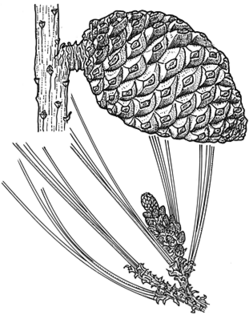
Description: Trees with regularly whorled branches; monoecious.
Shoots of 2 kinds, the long shoots bearing scale leaves without chlorophyll and with woody, decurrent bases, the short shoots borne in the axils of the scale leaves and consisting of a definite number of green, needle-like leaves surrounded by persistent sheathing scale leaves at the base, the shoot finally falling off as a unit.
Male cones replace short shoots at base of a new year's growth; sporophylls each producing 2 microsporangia on the lower surface. Female cones replace long shoots and usually ripen in the second year, the cone scales thin or woody; seeds 2 to each scale, usually winged.
Distribution and occurrence: World: c. 100 species, Northern Hemisphere. Australia: c. 11 species (naturalized), Qld, N.S.W., Vic., Tas., S.A., W.A.
Many species are cultivated as ornamental and timber trees in cooler parts of the world, a number have become naturalized in N.S.W.
Text by G. J. Harden
Taxon concept:
Taxa not yet included in identification key
Pinus halepensis,
Pinus mugo,
Pinus patula,
Pinus pinea,
Pinus ponderosa
| | Key to the species | |
| 1 | Leaves thin and flexible, mostly in groups of 3 (sometimes 2 or 4) on short shoots | 2 |
| Leaves stout and rigid, always in pairs, on short shoots | 4 |
| 2 | Leaves usually <15 cm long; cones ± asymmetrical | Pinus radiata |
| Leaves mostly >15 cm long; cones symmetrical
Back to 1 | 3 |
| 3 | Leaves always in groups of 3; cones sessile | Pinus taeda |
| Leaves in groups of 2–4; cones shortly stalked
Back to 2 | Pinus elliottii |
| 4 | Buds non resinous; leaves mostly 15–24 cm long | Pinus pinaster |
| Buds strongly resinous; leaves mostly 3–7 cm long
Back to 1 | Pinus contorta |
|


